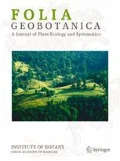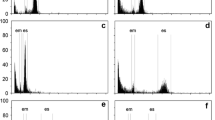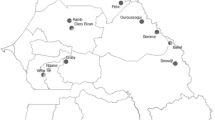Abstract
In agamic complexes, the ‘minority cytotype exclusion principle’ can be modified to the ‘sexual cytotype exclusion principle’: Apomicts produce polyploid progeny of maternal genotype without the need for pollination, but still produce pollen. Outcrossing sexuals thus suffer from unsuccessful hybridizations – they produce reduced amounts of progeny. This causes a decrease in the relative frequency of sexuals and later leads to their exclusion from the population. However, in the agamic complex Taraxacum sect. Taraxacum, diploid sexuals coexist with triploid apomicts in stabilized mixed populations. This paper deals with hybridizations in natural populations, the possibilities of new triploid apomicts originating and investigates why the 'sexual cytotype exclusion principle' does not work in Taraxacum sect. Taraxacum. The progeny of diploids from natural populations screened by the flow-cytometric seed screening method consisted only of diploids. Different simulations of natural pollinations were carried experimentally. When the flowers of a diploid received different mixtures of pollen of surrounding diploids and triploids, pollination was successful and only diploid progeny was produced, probably due to the preference of high-quality compatible pollen of diploids by diploid maternal plants. Therefore, the 'sexual cytotype exclusion principle' cannot work in Taraxacum sect. Taraxacum, and diploids and triploids can coexist in common populations. Polyploid progeny was produced by a diploid plant surrounded only by triploid apomicts to a certain distance. This suggests that new polyploid apomicts can be produced only in places where isolated diploids can occur among triploids. Newly formed apomicts further spread their progeny to both areas of apomicts and areas of mixed populations.



Similar content being viewed by others
References
Bierzychudek P (1985) Patterns in plant parthenogenesis. Experientia 41:1255–1264
Brock MT (2004) The potential for genetic assimilation of a native dandelion species, Taraxacum ceratophorum (Asteraceae), by the exotic congener T. officinale. Amer J Bot 91:656–663
Brock MT (2009) Prezygotic barriers to gene flow between Taraxacum ceratophorum and the invasive Taraxacum officinale (Asteraceae). Oecologia,161(2), 241–251
Cosendai AC, Hörandl E (2010) Cytotype stability, facultative apomixis and geographical parthenogenesis in Ranunculus kuepferi (Ranunculaceae). Ann Bot 105:457–470
Cosendai A, Wagner J, Ladinig U, Rosche C, Hörandl E (2013) Geographical parthenogenesis and population genetic structure in the alpine species Ranunculus kuepferi (Ranunculaceae). Heredity 110:560–569
de Kovel CGF, de Jong GJ (2000 ) Selection on apomictic lineages of Taraxacum at establishment in a mixed sexual-apomictic population. Evol Biol 13:561–568
Doležel J, Göhde W (1995) Sex determination in dioecious plants Melandrium album and M. rubrum using high-resolution flow cytometry. Cytometry 19:103–106
Elzinga D, van der Kamp J, Den Nijs JCM, Sterk AA (1987) Cytogeography and ecology of diploids and triploids of Taraxacum section Taraxacum in South Limburg, the Netherlands. Proc Kon Ned Akad Wetensch C 90:431–442
Furnkranz D (1966) Cytogenetische Unterschungen an Taraxacum im Raume von Wien. Oesterr Bot Z 107:310–350
Hörandl E (2006) The complex causality of geographical parthenogenesis. New Phytol 171:525–538
Hörandl E, Temsch EM (2009) Introgression of apomixis into sexual species is inhibited by mentor effects and ploidy barriers in the Ranunculus auricomus complex. Ann Bot 104:81–89
Husband BC (2000) Constraints on polyploid evolution: A test of the minority cytotype exclusion principle. Proc Roy. Soc Biol Sci Ser B 267:217–223
Husband BC (2004) The role of triploid hybrids in the evolutionary dynamics of mixed-ploidy populations. Biol J Linn Soc 82:537–546
Hörandl E, Dobeš C, Suda J, Vít P, Urfus T, Temsch EM, Cosendai A-C, Wagner J, Ladinig U (2011) Apomixis is not prevalent in subnival to nival plants of the European Alps. Ann Bot 108:381–390
Jenniskens MPJ, den Nijs JCM, Sterk AA (1985) Crossability and hybridization of taxa of Taraxacum section Taraxacum from central and western Europe. Proc Kon Ned Akad Wetensch C 88:297–338
Kandori I, Hirao T, Matsunaga S, Kurosaki T (2009) An invasive dandelion unilaterally reduces the reproduction of a native congener through competition for pollination. Oecologia, 159(3), 559–569
Kao RH (2007) Asexuality and the coexistence of cytotypes. New Phytol 175:764–772
Koutecký P, Baďurová T, Štech M, Košnar J, Karásek J (2011) Hybridization between diploid Centaurea pseudophrygia and tetraploid C. jacea (Asteraceae): the role of mixed pollination, unreduced gametes, and mentor effects. Bot J Linn Soc 104:93–106
Krahulcová A, Rotreklová O, Krahulec F, Rosenbaumová R, Plačková I (2009) Enriching ploidy level diversity: the role of apomictic and sexual biotypes of Hieracium subgen. Pilosella (Asteraceae) that coexist in polyploid populations. Folia Geobot 44:281–306
Levin DA (1975) Minority cytotype exclusion in local plant populations. Taxon 24:35–43
Majeský Ľ, Vašut RJ, Kitner M, Trávníček B (2012) The pattern of genetic variability in apomictic clones of Taraxacum officinale indicates the alternation of asexual and sexual histories of apomicts. PLoS ONE 7:e41868
Mártonfiová L (2006) Possible pathways of the gene flow in Taraxacum sect. Ruderalia. Folia Geobot 41:183–201
Matzk F, Meister A, Schubert I (2000) An efficient screen for reproductive pathways using mature seeds of monocots and dicots. Plant J 21:97–108
Meirmans PG, Calame FG, Bretagnolle F, Felber F, Den Nijs JCM (1999) Anthropogenic disturbance and habitat differentiation between sexual diploid and apomictic triploid Taraxacum sect. Ruderalia. Folia Geobot 34:451–469
Meirmans PG, Vlot EC, Den Nijs JCM, Menken SBJ, (2003) Spatial ecological and genetic structure of a mixed population of sexual diploid and apomictic triploid dandelions. J Evol Biol 16:343–352
Mikoláš V, Mihoková L (1994) Diploidi a polyploidi sekce Ruderalia Kirschner, Olgaard et Štěpánek rodu Taraxacum na Slovensku: Příspěvek k jejich studiu. In Zborník z 5. zjazdu SBS, Blatnica, 1995, pp 92–97
Mogie M (2011) Pollen profile, spatial structure, and access of sex in asexual hermaphrodites. Bot J Linn Soc 103:954–966
Mogie M, Ford H (1988) Sexual and asexual Taraxacum species. Biol J Linn Soc 35:155-168
Morita T, Menken SBJ, Sterk AA (1990) Hybridization between European and Asian dandelions (Taraxacum section Ruderalia and section Mongolica). 1. Crossability and breakdown of self-incompatibility. New Phytol 114:519–529
Murín A (1960) Substitution of cellophane for glass covers to facilitate preparation of permanent squashes and smears. Stain Technol 35:351–353
Nishida S, Kanaoka MM, Hashimoto K, Takakura KI, Nishida T (2014). Pollen-pistil interactions in reproductive interference: comparisons of heterospecific pollen tube growth from alien species between two native Taraxacum species. Funct Ecol 28(2), 450–457
Otto FJ (1990) DAPI staining of fixed cells for high-resolution flow cytometry of nuclear DNA. In Darzynkiewicz Z Crissman HA (eds): Methods in Cell Biology 33:105 –110, Academic Press, San Diego.
Pierre J (2001) The role of honeybees (Apis mellifera) and other insect pollinators in gene flow between oilseed rape (Brassica napus) and wild radish (Raphanus raphanistrum) (Conference Paper). Acta Hort 561:47–51
Pontin DR, Wade MR, Kehrli P, Wratten SD (2006) Attractiveness of single and multiple species flower patches to beneficial insects in agroecosystems. Ann Appl Biol 148:39–47
Richards AJ (1970) Hybridization in Taraxacum. New Phytol 69:1103–1121
Richards AJ (1997) Plant breeding systems. Chapmann & Hall, London
Slaa EJ, Cevaal A, Sommeijer MJ (1998) Floral constancy in Trigona stingless bees foraging on artificial flower patches: A comparative study. J Apicult Res 37:191–198
Šafářová L, Duchoslav M (2010) Cytotype distribution in mixed populations of polyploid Allium oleraceum measured at a microgeographic scale. Preslia 82:107–126
Takakura K-I, Nishida T, Matsumoto T, Nishida S (2009) Alien dandelion reduces the seed set of a native congener through frequency-dependent and one-sided effects. Biol Invas 11:973–981
Takakura KI, Matsumoto T, Nishida T, Nishida S (2011). Effective range of reproductive interference exerted by an alien dandelion, Taraxacum officinale, on a native congener. J Pl Res, 124(2), 269–276
Tas ICQ, van Dijk PJ (1999) Crosses between sexual and apomictic dandelions (Taraxacum). I. The inheritance of apomixis. Heredity 83:707–714
Tschermak-Woess E (1949) Diploides Taraxacum vulgare in Wien und Niederösterreich. Oesterr Bot Z 96:56–63
van der Hulst RGM, Mes THM, den Nijs JCM, Bachmann K (2000) Amplified fragment length polymorphism (AFLP) markers reveal that population structure of triploid dandelions (Taraxacum officinale) exhibits both clonality and recombination. Molec Ecol 9:1–8
van Dijk PJ, van Baarlen P, de Jong JH (2003) The occurrence of phenotypically complementary apomixis-recombinants in crosses between sexual and apomictic dandelions (Taraxacum officinale). Sexual Pl Reprod 16:71–76
van Dijk PJ (2007) Potential and realized costs of sex in dandelions Taraxacum officinale. s.l. In Apomixis: evolution, mechanisms and perspectives. E. Hörandl, U. Grossniklaus, P.J. van Dijk and T.F. Sharbel, eds. A.R. G. Gantner K.G. Rugell, Liechtenstein. pp 215–234
Vandel A (1928) La parthénogenèse geographique. Contribution à l´étude biologique et cytologique de la parthénogenèse naturelle. Bull. Biol. France Belgique 62:164–281
Verduijn MH, van Dijk PJ, van Damme JMM (2004a) The role of tetraploids in the sexual – asexual cycle in dandelions (Taraxacum). Heredity 93:390–398
Verduijn MH, van Dijk PJ, van Damme JMM (2004b) Distribution, phenology and demography of sympatric sexual and asexual dandelions (Taraxacum officinale s.l.): geographic parthenogenesis on a small scale. Biol J Linn Soc 82:205–218
Acknowledgements
The support for this research was provided by the APVV Grant Agency, Slovakia (APVV 0320-10). FCM analyses were done using equipment purchased with the support of EU Structural funds (project NEXO-Network of Excellence in Oncology, No. 007/20092.1/OPVaV). My thanks are also due to P. Mártonfi (Dept. of Botany, Institute of Biology and Ecology, Faculty of Science, P.J. Šafárik University in Košice, Slovakia) for his careful reading of the manuscript and comments.
The experiments performed comply with current laws in Slovakia.
Author information
Authors and Affiliations
Corresponding author
Rights and permissions
About this article
Cite this article
Mártonfiová, L. Hybridization in natural mixed populations of sexual diploid and apomictic triploid dandelions (Taraxacum sect. Taraxacum): Why are the diploid sexuals not forced out?. Folia Geobot 50, 339–348 (2015). https://doi.org/10.1007/s12224-015-9231-y
Received:
Accepted:
Published:
Issue Date:
DOI: https://doi.org/10.1007/s12224-015-9231-y




